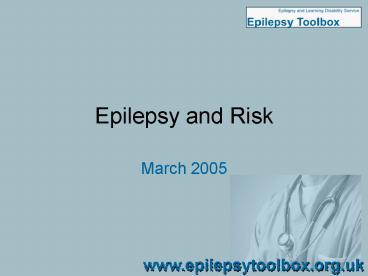Epilepsy and Risk - PowerPoint PPT Presentation
1 / 15
Title:
Epilepsy and Risk
Description:
Morbidity- effects which result in injury, harm, ill health, ... Tonic clonic. Tonic. Fractures to head, face, long bones, collar bone. Teeth and nose breaks. ... – PowerPoint PPT presentation
Number of Views:50
Avg rating:3.0/5.0
Title: Epilepsy and Risk
1
Epilepsy and Risk
- March 2005
2
Some Factors which affect epilepsy Risk
Underlying Causes
Health
Environment
Relationships
EPILEPSY
Seizures
Income
Education
Employment
Personality
Support
Treatment
3
What are the risks associated with Epilepsy?
- Evidenced risks (significant literature)
- Morbidity- effects which result in injury, harm,
ill health, disease, poisoning, adverse effect on
normal functioning - Mortality- death
- Relationship between epilepsy and a negative
impact on psycho-social functioning
4
Morbidity from epilepsy
- Effects of treatment and medication, including
toxicity, and interactions - Side effects of AEDs
- Brand name AEDs are not interchangeable with
generic preparations
- Illness or disease as part of the underlying
condition - Mental Illness is more common, depression,
anxiety disorder
5
Morbidity risks from seizures
- Falls
- Atonic,
- Tonic clonic
- Tonic
- Fractures to head, face, long bones, collar
bone. Teeth and nose breaks. Spinal injuries
(e.g.) - Cuts and contusions
- Environment crucial
- All Seizures
- Burns (also common with partial seizures, example
from video, example from case load) - Risk from loss of awareness, esp. traffic, water,
fire - psychosis
- Locus of control
- Status Epilepticus
6
Mortality and epilepsy
- Mortality rates are higher than for the general
population (at least twice as high) - Greater in the learning disabled population
- Related to concomitant or underlying conditions,
e.g. syndromes, deteriorative conditions brain
tumours etc
7
Sudden Unexpected Death in Epilepsy (SUDEP) 1200
deaths per year in LD, Factors which increase
risk include
- Nocturnal/ unwitnessed seizure
- Uncontrolled seizures
- Medication changes, not taking medication
regularly - Alcohol abuse
- Male
- Learning Disability
- SUDEP further information available
8
Drowning
- Drowning in the domestic bath is the most common
cause of accidental death, for people who have
epilepsy (examples) - Drowning while swimming does occur but is much
less common - Mechanisms involved
- Accidental drowning does happen but is relatively
rare, and risk may depend on external factors
such as exposure to water features, level of
support etc
9
Mortality and Seizures cont
- Status Epilepticus associated with morbidity and
mortality (next slide) - Choking / aspiration
- Breathing difficulties
- Underlying cause of Epilepsy
10
Serial seizures
seizures occurring one after another without full
recovery in between
Prolonged seizures
seizures lasting at least two minutes longer than
usual or five minutes in total
any seizures without the person regaining
consciousness or breathing properly between
attacks lasting 30 minutes
Status epilepticus
This can be life threatening and therefore
requires urgent medical attention
11
Environment
- Probably has most impact on seizures which
involve falls. Examples - stairs, heights, hard surfaces, sharp corners
edges to furniture, bathroom fixtures, showers
heating, hot water, glass doors/ tables (e.g.
Dutch School) - Frequently used areas carry more risk
- Pillows
- External environment, e.g. train journey, water
12
HEALTH
- Impact of epilepsy on health and vice versa
Seizures lower cognition
Infection leads to increase in seizures
Low cognition affects bodily function e.g.
swallow
Lowered function affects health e.g. aspiration
chest infection
13
Assessing Managing Epilepsy Riskcontext
- Help us to carry out duty of care
- and staff from foreseeable/ preventable risk
- Protect clients Legislation and guidelines
- Health and safety at work act1974 set out
framework - Management of health and safety at work
regulations 1992 - Adults with incapacity
- Epilepsy practice/clinical guidelines SIGN, NICE,
IASSID - IASSID- individual risk assessment take account
of severity of epilepsy, 1. bathing and showering
2. management of acute seizure 3.impact of
epilepsy in social settings - Mental Welfare Commission and court cases look
for evidence of risk assessment and joint care
plans (examples)
14
Examples of managing Risk
- Use of rescue medication
- Use of mobile phone and flexible staffing
- Epilepsy bed alarm/ listening device (?intrusion)
as part of nocturnal seizure management - Hand out example (risk identification)
- Balancing risk and quality of life
- Using guidelines and standards, MCN and SPEC
15
Epilepsy Factors in Risk Assessment
- These factors should be incorporated into your
risk assessment process - The severity of the possible outcome (e.g.. If
death from drowning then other factors do not
carry as high weighting) - The seizure type severity and frequency
- The predictability of seizures
- Triggers present
- The history of epilepsy/ seizures/ and risk
activity - The frequency of exposure to risk































